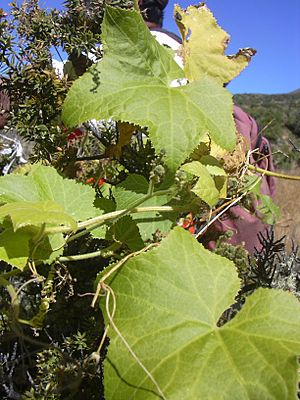Alpine bur cucumber facts for kids
Quick facts for kids Alpine bur cucumber |
|
|---|---|
 |
|
| Conservation status | |
| Scientific classification | |
| Genus: |
Sicyos
|
| Species: |
macrophyllus
|
Sicyos macrophyllus is a very rare flowering plant. It belongs to the Cucurbitaceae, which is the squash family. This plant is found only in Hawaii, specifically on the island of Hawaii. It might have disappeared from the island of Maui. Some common names for it are alpine bur cucumber, largeleaf bur-cucumber, and 'anunu.
Contents
About the Alpine Bur Cucumber
What Does It Look Like?
This plant is a perennial herb. This means it lives for more than two years. It grows long vines, up to 15 meters (about 50 feet) in length. These vines can also be quite thick, up to 4 centimeters (about 1.5 inches) across.
The plant uses special parts called tendrils to help it climb and hold on. Its stems are a bit hairy and have small black spots. The leaves are shaped with different sections, like lobes. The top of the leaves is smooth, but the underside is hairy. When it flowers, the blooms are a greenish-yellow color. The fruit of the plant is round.
Where Does It Live?
You can find Sicyos macrophyllus on the island of Hawaii. It grows at high elevations, between 1200 and 2000 meters (about 3,900 to 6,500 feet) above sea level.
It prefers wet forests where the ʻōhiʻa lehua tree is common. It also lives in subalpine forests. These higher-elevation forests often have māmane and naio trees. This rare plant can be found inside Hawaii Volcanoes National Park.
Why Is It So Rare?
There are only about 24 to 26 individual Sicyos macrophyllus plants left in the world. Even though it's very rare, the United States government has not officially listed it as an endangered species. However, in 1990, the government considered it for protection.
The United States Fish and Wildlife Service believes this plant is "highly threatened." This means it is in great danger. They also think the threats are "imminent," meaning they are happening right now.
What Are the Main Threats?
One big reason for the plant's decline is Habitat destruction. This means its natural home is being damaged or destroyed.
- Animals causing harm: Wild pigs, sheep, and cattle roam freely. They eat native plants and cause erosion on hills. Erosion is when soil is washed away. These animals also spread seeds of introduced species of plants. Many of these are harmful noxious weeds. Cattle will even eat S. macrophyllus directly.
- Competition from other plants: Another major threat comes from plants that are not native to Hawaii. These are called alien or invasive species. Some of the worst ones are fountain grass, kikuyu grass, and German ivy. These invasive plants can smother other plants. They also compete for important resources like water and sunlight. Some can even increase the risk of fires. They stop new native plants from growing. Some even release chemicals that prevent other plants from growing nearby.
What's Being Done to Help?
The National Park Service is working to save Sicyos macrophyllus from extinction. They have put up fences around some of the few remaining plants. This helps protect them from animals. They also try to control the invasive plants that threaten the species.
The National Tropical Botanical Garden is also helping. They have collected and stored some seeds from S. macrophyllus. This is like a backup plan to help grow new plants in the future.


